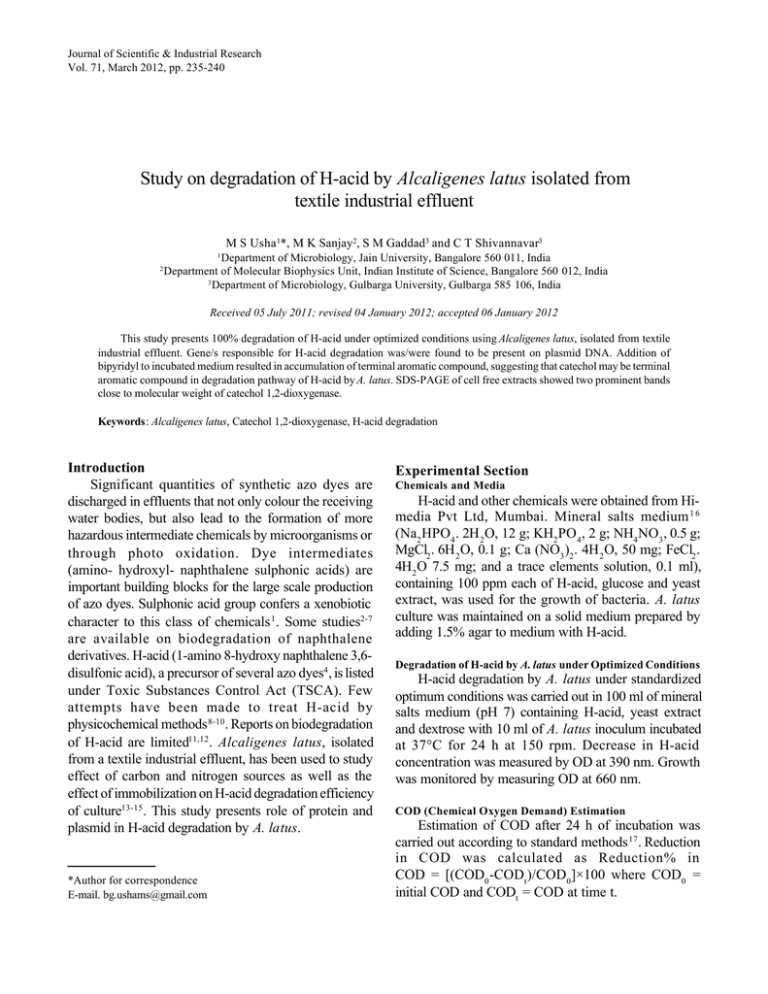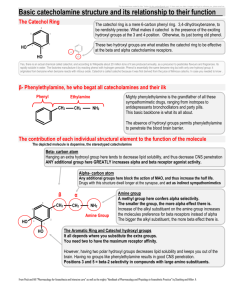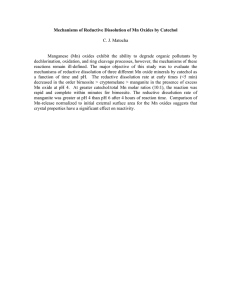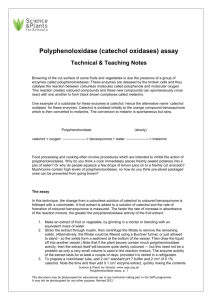Alcaligenes latus textile industrial effluent 235 M S Usha
advertisement

Journal of Scientific & IndustrialUSHA Research et al: DEGRADATION OF H-ACID BY ALCALIGENES LATUS Vol. 71, March 2012, pp. 235-240 235 Study on degradation of H-acid by Alcaligenes latus isolated from textile industrial effluent M S Usha 1*, M K Sanjay2, S M Gaddad3 and C T Shivannavar3 1 2 Department of Microbiology, Jain University, Bangalore 560 011, India Department of Molecular Biophysics Unit, Indian Institute of Science, Bangalore 560 012, India 3 Department of Microbiology, Gulbarga University, Gulbarga 585 106, India Received 05 July 2011; revised 04 January 2012; accepted 06 January 2012 This study presents 100% degradation of H-acid under optimized conditions using Alcaligenes latus, isolated from textile industrial effluent. Gene/s responsible for H-acid degradation was/were found to be present on plasmid DNA. Addition of bipyridyl to incubated medium resulted in accumulation of terminal aromatic compound, suggesting that catechol may be terminal aromatic compound in degradation pathway of H-acid by A. latus. SDS-PAGE of cell free extracts showed two prominent bands close to molecular weight of catechol 1,2-dioxygenase. Keywords: Alcaligenes latus, Catechol 1,2-dioxygenase, H-acid degradation Introduction Significant quantities of synthetic azo dyes are discharged in effluents that not only colour the receiving water bodies, but also lead to the formation of more hazardous intermediate chemicals by microorganisms or through photo oxidation. Dye intermediates (amino- hydroxyl- naphthalene sulphonic acids) are important building blocks for the large scale production of azo dyes. Sulphonic acid group confers a xenobiotic character to this class of chemicals 1 . Some studies2-7 are available on biodegradation of naphthalene derivatives. H-acid (1-amino 8-hydroxy naphthalene 3,6disulfonic acid), a precursor of several azo dyes4 , is listed under Toxic Substances Control Act (TSCA). Few attempts have been made to treat H-acid by physicochemical methods 8-10. Reports on biodegradation of H-acid are limited11,12. Alcaligenes latus, isolated from a textile industrial effluent, has been used to study effect of carbon and nitrogen sources as well as the effect of immobilization on H-acid degradation efficiency of culture13-15. This study presents role of protein and plasmid in H-acid degradation by A. latus. *Author for correspondence E-mail. bg.ushams@gmail.com Experimental Section Chemicals and Media H-acid and other chemicals were obtained from Himedia Pvt Ltd, Mumbai. Mineral salts medium 1 6 (Na2 HPO4 . 2H 2 O, 12 g; KH2 PO4 , 2 g; NH4 NO3 , 0.5 g; MgCl2 . 6H 2 O, 0.1 g; Ca (NO3 )2 . 4H 2 O, 50 mg; FeCl2 . 4H2 O 7.5 mg; and a trace elements solution, 0.1 ml), containing 100 ppm each of H-acid, glucose and yeast extract, was used for the growth of bacteria. A. latus culture was maintained on a solid medium prepared by adding 1.5% agar to medium with H-acid. Degradation of H-acid by A. latus under Optimized Conditions H-acid degradation by A. latus under standardized optimum conditions was carried out in 100 ml of mineral salts medium (pH 7) containing H-acid, yeast extract and dextrose with 10 ml of A. latus inoculum incubated at 37°C for 24 h at 150 rpm. Decrease in H-acid concentration was measured by OD at 390 nm. Growth was monitored by measuring OD at 660 nm. COD (Chemical Oxygen Demand) Estimation Estimation of COD after 24 h of incubation was carried out according to standard methods 17 . Reduction in COD was calculated as Reduction% in COD = [(COD0 -CODt )/COD0 ]×100 where COD0 = initial COD and CODt = COD at time t. 236 J SCI IND RES VOL 71 MARCH 2012 TLC and Spectral Analysis Culture filtrate was acidified (pH 4) and products of H-acid degradation were extracted with diethyl ether and dried. Concentrated metabolites were isolated and purified by TLC using chloroform:acetone (80:20) and cyclohexane:ethyl acetate:acetone (4:1:1) as mobile phases. Spots were observed after exposing plates to iodine vapors. Bands obtained on chromatogram were separated and compounds were eluted with diethyl ether. Compounds were then kept for evaporation and sent to IISc, Bangalore and CDRI, Lucknow for IR and NMR analysis. Plasmid Isolation and Plasmid Curing Plasmid DNA was isolated from A. latus cells by a modified alkaline lysis method18 . Isolated samples were electrophoresed on 1% agarose gel. Plasmid curing of A. latus culture was carried out up to 6 days using 300 µg/ml of acridine orange. Curing was verified by the absence of plasmids relative to the presence of these plasmids in original parent strain. Cured colonies were checked for their ability to use H-acid by inoculating them in mineral salts medium with H-acid as a sole source of carbon. Determination of Terminal Aromatic Compound (TAC) Replacement study was carried out to inhibit dioxygenase enzyme activity, involved in ring cleavage mechanism, resulting in accumulation of TAC (catechol or protocatechuic acid). For this, A. latus cells (2 g wet wt) were suspended in 50 ml of 0.5 M PO4 buffer (pH 7), to which 0.5 mM bipyridyl and 10 mg of H-acid were added. Here, bipyridyl acts as inhibitor for dioxygenase enzyme. Reaction mixture was then incubated at 37°C for 24 h, the product of H-acid degradation was extracted with diethyl ether and TLC was carried out in different solvents along with catechol and protocatechuic acid for comparison. Mode of H-Acid Ring Cleavage Mode of ring cleavage of TAC such as catechol was determined by reported method19 using whole cells and also by another method20 using cell-free extract (CFE). Rothera’s 21 test was performed to determine ring cleavage pathway of TAC, catechol, using whole cells and CFEs. Enzyme Assays (EAs) EAs were carried out with CFE of A. latus and ammonium sulphate precipitated spent medium. Catechol 2, 3-dioxygenase activity was detected by reported method22 . EA system contained: 10 mM catechol, 0.1; CFE, 0.1; and 0.1 M phosphate buffer (pH 7.5), 2.8 ml. Reaction was initiated by addition of catechol and increase in absorbance at 375 nm (ε - 33,500) due to formation of α-hydroxymuconic semialdehyde was measured. Catechol 1, 2-dioxygenase activity was determined by reported method23 . EA system contained: 0.001 M catechol, 0.3; 0.01 M EDTA, 0.2; phosphate buffer (pH 7.0), 2; CFE, 0.2; and distilled water, 0.3 ml. Reaction was initiated by addition of catechol and enzyme activity was measured spectrophotometrically by monitoring the increase in absorbance at 260 nm (ε - 16,900) due to the formation of cis, cis-muconic acid in reaction mixture. Protocatechuic acid 3,4-dioxygenase activity was determined by reported method24 . EA system contained: 0.1 M phosphate buffer (pH 7.0), 2; and CFE + distilled water, 2.5 ml. Reaction was initiated by addition of 0.001 M sodium protocatechuate (0.5 ml). Enzyme activity was measured spectrophotometrically by monitoring the increase in absorbance at 290 nm (ε - 3890) due to formation of β - carboxy cis,cis-muconic acid. Growth of A. latus in Presence of Other Aromatic Hydrocarbons After adaptation of A. latus to H-acid degradation, its efficiency was checked for the utilization of other aromatic hydrocarbon as a sole source of carbon. A. latus culture (10 ml) was inoculated into 100 ml of mineral salts medium containing 100 ppm each of 1-amino naphthalene 2-sulfonic acid, catechol and protocatechuic acid separately along with 100 ppm of yeast extract and dextrose. Flasks were incubated at 37°C for 10 days. After incubation, growth of A. latus in presence of different aromatic hydrocarbons was monitored by measuring OD at 660 nm. Protein Pattern of A. latus by SDS-PAGE SDS-PAGE was performed by reported method25 . CFE and ammonium sulphate precipitated spent medium were used as source of proteins. Discontinuous SDSpolyacrylamide gel (10%) was used for separation of proteins. Electrophoresis was performed after loading gels with same amount of protein from CFEs and spent medium along with molecular weight markers by applying constant current. Electroporesed gels were stained with coomassie brilliant blue R250. Major bands were compared with known molecular weight standards. For molecular weight determination of enzyme, molecular weight standards used were ovalbumin (Mr 43,400), 237 USHA et al: DEGRADATION OF H-ACID BY ALCALIGENES LATUS 120 100 80 % 60 40 20 0 0 6 12 18 24 30 36 42 48 h Fig. 1—Degradation of H-acid by A. latus under optimized conditions at 100 ppm of H-acid Fig. 2—TLC showing spots of H-acid and its degraded product with chloroform : acetone solvent system Table 1—Rf values of H-acid, its degraded product and authentic compounds in different solvent systems Solvent systems Chloroform : acetone Cyclohexane : ethyl acetate : acetone 0.19 0.23 0.28 0.33 0.09 0.19 0.0 0.1 % Compound H-acid Degradation product Catechol Protocatechuic acid Fig. 3—Agarose gel showing plasmid isolated from A. latus carbonic anhydrase (M r 29,000), triose phosphate isomerase (Mr 26,600), trypsin inhibitor (Mr 20,100), αlactalbumin (Mr 14,200), apsotinin (Mr 6,500) and insulin (Mr 3,500). Results H-acid degradation (100%) by A. latus under standardized optimum conditions (Fig. 1) was recorded within 24 h of incubation. After 24 h, 92% reduction in COD was recorded. With cyclohexane:ethyl acetate:acetone (4:1:1) and chloroform:acetone (80:20) as solvent systems, a single broad band with tailing was observed not corresponding to H-acid band (Fig. 2). Days Fig. 4—Plasmid curing of A. latus Rf values of H-acid and degradation product in different solvent systems are given in Table 1. IR and 1 H NMR spectra of H-acid and its degraded product confirmed degradation of H-acid by A. latus (data not shown). A single band of plasmid was observed on agarose gel (Fig. 3). Plasmid curing was 36.35% curing on first day and it increased gradually to 95.84% by 5th day (Fig. 4). This was further confirmed with decrease in thickness of plasmid band on agarose gel with increase in incubation 238 J SCI IND RES VOL 71 MARCH 2012 Table 2—Different enzyme activity in cell free extract and spent medium of A. latus Enzyme Catechol-1,2-dioxygenase Catechol-2,3-dioxygenase Protocatechuic acid-3,4- Cell free extract (CFE), U/g* 2 0.4 0 dioxygenase Ammonium sulphate precipitated spent medium, U/g 4 0.6 0 *Units/gram protein period. Plasmid DNA cured A. latus cells were able to grow on nutrient agar, but failed to grow on mineral salts agar medium containing H-acid as sole source of carbon. This indicated that genes responsible for degradation of H-acid are present on plasmid DNA. A. latus cells were incubated with H-acid and dioxygenase inhibitor, bipyridyl, for 24 h. Formation of purple colour in reaction mixture indicated accumulation of TACs. Then the product extracted with solvent gave a single band on TLC, which corresponded to catechol band, suggesting that catechol may be TAC in degradation pathway of H-acid by A. latus. When Rothera’s test was performed to determine ring cleavage pathway of TAC, both whole cells and cell extracts did not develop yellow colour on addition of buffer and catechol. Further, addition of ammonium sulphate to saturation, freshly prepared sodium nitropruside and concentrated ammonium hydroxide after incubation resulted in strong violet colour. This indicated that organism has followed ortho-cleavage pathway for degradation of H-acid. To confirm degradation of catechol by ortho cleavage, probable key enzymes (catechol 1, 2dioxygenase, catechol 2, 3-dioxygenase and protocatechuic acid 3, 4-dixoygenase) were assayed by spectrophotometric methods using CFE and ammonium sulphate precipitated spent medium from A. latus culture (Table 2). CFE of A. latus showed slightly higher activities of catechol 1, 2-dioxygenase and moderate activities of catechol 2,3-dioxygenase. Specific activity of catechol 1, 2-dioxygenase in extract was found to be 2 U/g of protein and that of catechol 2, 3-dioxygenase was 0.4 U/g of protein. Similar results were obtained with ammonium sulphate precipitated spent medium. Specific activity of catechol 1, 2-dioxygenase was 4 U/g of protein and that of catechol 2, 3-dioxygenase was 0.6 U/g of protein. No activity was observed for protocatechuic acid 3, 4-dioxygenase activity with both CFE and spent medium. Mol wt Fig. 5—Protein profile of A. latus Utilization of different aromatic hydrocarbons as sole source of carbon and energy by A. latus showed turbidity as follows: 1-amino naphthalene 2-sulfonic acid, 0.396; catechol, 0.325; and protocatechuic acid, 0.073 OD. Results suggest that H-acid is catabolized through catechol, not through the protocatechuic acid pathway, and A. latus has a wide substrate utilizing capacity. Ammonium sulphate precipitated proteins from spent medium and crude extracts from A. latus were subjected to SDS-PAGE. No bands were obtained from spent medium, but many bands were obtained with CFEs of A. latus; of two bands between ovalbumin (43.4 kDa) and carbonic anhydrase (29 kDa), one could be catechol 1, 2dioxygenase subunit (32 kDa) (Fig. 5). Discussion Plasmid isolation and plasmid curing revealed that A. latus contains a single plasmid. Plasmid was found to be lost during successive cycles and after fifth day, H-acid degrading ability of bacteria was completely lost. This indicates that gene(s) responsible for degradation 239 USHA et al: DEGRADATION OF H-ACID BY ALCALIGENES LATUS of H-acid are present on plasmid DNA, and not on genomic DNA of A. latus. Burton et al26 reported that 15% of aerobic heterotrophic bacteria isolated from sediment of a river receiving domestic and industrial effluents carried plasmids compared with 10% of bacteria from an unpolluted area upstream. Kuhm et al27 reported that gene encoded for degradation of naphthalene sulphonic acids in Pseudomonas paucimobilis is present on a plasmid. TAC formed in catabolic process of H-acid by A. latus was identified to be catechol. Solvent extraction and TLC analysis of purple coloured compound showed single band corresponding to catechol. Thus catechol appears to be intermediate metabolite (TAC) in H-acid degradation by A. latus. Addition of bipyridyl as inhibitor to dioxygenase, an enzyme in H-acid degradation, leads to accumulation of catechol as TAC. Rapid utilization of catechol as sole carbon and energy source by A. latus supports that catechol is TAC formed during catabolism of H-acid. Catabolism of most of the substituted or unsubstituted naphthalene sulphonates and disulphonates occurs via salicylate and gentisate pathway during bacterial degradation. Formation of catechol as a TAC during catabolism of H-acid by A. latus suggests that it might follow amino salicylate and catechol pathway. Notremann et al2 reported that amino or hydroxy salicylic acid is formed during degradation of amino or hydroxy naphthalene sulphonic acids. Further salicylic acid can be converted to catechol or gentisic acid before undergoing ring cleavage 28,29. Enzyme investigations in CFE of A. latus showed a significant activity of catechol 1,2-dioxygenase and less activity of catechol 2,3-dioxygenase. Activities of these enzymes were almost double in spent medium concentrated with ammonium sulphate precipitation. Protocatechuic acid 3,4-dioxygenase activity was not observed in both spent medium and CFEs. Presence of high activity of catechol 1,2-dioxygenase and no activity of protocatechuic acid 3,4-dioxygenase in both spent medium and CFEs indicates that A. latus follows ortho ring cleavage of catechol. Luxurious growth of this bacterium in a medium containing catechol and 1-amino naphthalene 2-sulphonate and no growth with protocatechuic acid supports mineralization of H-acid by A. latus through ortho cleavage and also suggests that enzymes involved in catabolism are of broad spectrum. Protein profile of CFE of A. latus revealed the presence of a prominent protein band corresponding to 32 kDa, which can be assumed as a catechol 1,2-dioxygenase. NH2 HO3S OH SO3H H-acid SO3 SO4 OH X COOH Salicylic acid OH OH Catechol Catechol 1,2-dioxygenase Ring cleavage Acetate + Succinate TCA cycle Fig. 6—Tentative pathway for degradation of H-acid by A. latus Nakari et al30 partially purified catechol 1,2-dioxygenase (mol wt, 32 kDa) from P. putida. Nortemann et al5 have shown that amino or hydroxy salicylic acid is formed during degradation of amino or hydroxy naphthalene sulphonic acids. Further salicylic acid can be converted to catechol or gentisic acid before undergoing ring cleavage 28,29. From present study and available reports on chemical degradation of H-acid, substituted naphthalene disulphonates and naphthalene sulphonates, probable catabolic pathway is proposed (Fig. 6) for degradation of H-acid followed by A. latus. This proposed pathway needs to be confirmed by identifying enzymes involved and intermediates formed during formation of catechol from H-acid. Conclusions A. latus has been found an efficient organism in degrading H-acid under optimized conditions. Genes responsible for H-acid is present on plasmid DNA. Enzyme activities and SDS-PAGE studies reveal the presence of catechol 1,2-dioxygenase enzyme in A. latus. Though a tentative pathway for degradation of H-acid by A. latus has been proposed, further confirmation of intermediary compounds and enzymes involved in each step needs to be carried out. 240 J SCI IND RES VOL 71 MARCH 2012 Acknowledgement Authors thank Gulbarga University, Gulbarga for fellowship during research work. 14 15 References 1 2 3 4 5 6 7 8 9 10 11 12 13 Kertesz M A, Cook A M & Leisinger T, Microbial metabolism of sulfur- and phosphorus-containing xenobiotics, FEMS Microbiol Rev, 15 (1994) 195-215. Nortemann B, Kuhm A E, Knackmuss H J & Stolz A, Conversion of substituted naphthalenesulfonates by Pseudomonas sp. BN6, Arch Microbiol, 161 (1994) 320-327. Nortemann B, Glasser A, Machinek R, Remberg G & Knackmuss H J, 5-Hydroxyquinoline-2-carboxylic acid, a dead-end metabolite from the bacterial oxidation of 5aminonaphthalene-2-sulfonic acid, Appl Environ Microbiol, 59 (1993) 1898-1903. Wittich R. M, Rast H G & Knackmuss H J, Degradation of Naphthalene-2,6- and Naphthalene-1,6- Disulfonic acid by a Moraxella sp., Appl Environ Microbiol, 54 (1988) 1842-1847. Nortemann B, Baumgarten J, Rast H G & Knackmuss H J, Bacterial communities degrading amino- and hydroxynaphthalene-2-sulfonates, Appl Environ Microbiol, 52 (1986) 1195-1202. Ohe T & Watanabe Y, Degradation of 2-Naphthylamine-1sulfonic acid by Pseudomonas sp. strain TA-1, Agric Biol Chem, 50 (1986) 1419-1426. Diekmann R, Nortemann B, Hempel D C & Knackmuss H J, Degradation of 6-aminonaphthalene sulphonic acid by mixed cultures: Kinetic analysis, Appl Microbiol Biotechnol, 29 (1988) 85-88. Noorjahan M, Pratap R M, Durga K V, Lavedrine B, Boule P et al, Photocatalytic degradation of H-acid over a novel TiO 2 thin film fixed bed reactor and in aqueous suspensions, J Photochem Photobiol A, 156 (2003) 179-187. Swaminathan K, Sandhya S, Carmalin S A, Pachhade K & Subrahmanyam Y V, Decolorization and degradation of H-acid and other dyes using ferrous-hydrogen peroxide system, Chemosphere, 50 (2003) 619-625. Rao N N, Gaurav B, Pradnya K & Kaul S N, Fenton and Electro-Fenton methods for oxidation of H-acid and Reactive Black 5, J Environ Engg, 132 (2006) 367-376. Rehorek A, Urbig K, Meurer R, Schäfer C, Plum A et al, Monitoring of azo dye degradation processes in a bioreactor by on-line high-performance liquid chromatography, J Chrom A, 949 (2002) 263-268. Mohanty S, Nageswara N R, Pradnya K & Santosh N K, A coupled photocatalytic-biological process for degradation of 1-amino-8-naphthol-3,6-disulfonic acid (H-acid), Wat Res, 39 (2005) 5064-5070. Usha M S, Sanjay M K, Shivannavar C T & Gaddad S M, Degradation of H-acid by bacteria, J Soil Biol, 25 (2004) 39-46. 16 17 18 19 20 21 22 23 24 25 26 27 28 29 30 Usha M S, Shivannavar C T & Gaddad S M, Effect of carbon and nitrogen sources on degradation of H-acid. Proc ICCE-2005 (Indore) 24-26 Dec 2005, 431-433. Usha M S, Sanjay M K, Gaddad S M & Shivannavar C T, Degradation of H-acid by free and immobilized cells of Alcaligenes latus, Braz J Microb, 41 (2010) 931-945. Brilon C, Beckmann W, Hellwig M & Knackmuss J, Enrichment and isolation of naphthalene sulfonic acid – utilizing Pseudomonads, Appl Environ Microbiol, 42 (1981) 39-43. Standard Methods for Examination of Water and Wastewaters, 20th edn (American Public Health Association, Washington D C) 1998. Birnboim H C, A rapid alkaline extraction method for the isolation of plasmid DNA, Meth Enzymol, 100 (1983) 243-255. Stanier R Y, Palleroni N J & Doudoroff M, The aerobic Pseudomonads: a taxonomic study, J Gen Microbiol, 43 (1966) 159-271. Eaton R W & Ribbons D W, Metabolism of dibutylphthalate and phthalate by Micrococcus sp. strain 12B, J, Bacteriol, 151 (1982) 48-57. Rothera A C H, Note on the nitroprusside reaction for acetone, J Physiol, 37 (1908) 491-494. Feist C F & Hegeman G D, Phenol and benzoate metabolism by Pseudomonas putida: Regulation of tangential pathways, J Bacteriol, 100 (1969) 869-877. Hegeman G D, Synthesis of the Enzymes of the Mandelate Pathway by Pseudomonas putida I, Synthesis of Enzymes by the Wild Type, J Bacteriol, 91 (1966) 1140-1154. Stanier R Y & Ingraham J I, Protocatechuic acid oxidase, J Biol Chem, 210 (1954) 799-808. Sambrook J, Fritsch E F & Maniatis T, Molecular Cloning: A Laboratory Manual, 2nd edn (Cold Spring Harbor Laboratory Press, Cold Spring Harbor, New York) 1989. Burton N F, Day M J & Bull A T, Distribution of bacterial plasmids in clean and polluted sites in a South Wales river, Appl Environ Microbiol, 44 (1982) 1026-1029. Kuhm A E, Stolz A, Ngai K L & Knackmuss H J, Purification and characterization of a 1,2-dihydroxy naphthalene dioxygenase from a bacterium that degrades naphthalenesulfonic acid, J Bacteriol, 173 (1991) 3795-3802. Cerniglia C E, Microbial metabolism of polycyclic aromatic hydrocarbons, Adv Appl Microbiol, 30 (1984) 31-71. Gibson D T & Subramanian V, Microbial Degradation of Organic Compounds, edited by D T Gibson (Marcel Dekker, Inc., New York) 1984, 181-252. Nakari C, Nakazawa T & Nozaki M, Purification and properties of catechol 1,2-dioxygenase (pyrocatechase) from Pseudomonas putida mt-2 in comparison with that from Pseudomonas arvilla C-1, Arch Biochem Biophys, 267 (1988) 701-713.


![Pre-workshop questionnaire for CEDRA Workshop [ ], [ ]](http://s2.studylib.net/store/data/010861335_1-6acdefcd9c672b666e2e207b48b7be0a-300x300.png)




